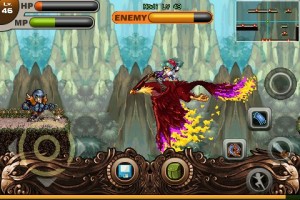 Last Action Heroine
Last Action Heroine
As we wrote in our hands-on preview last week, Samurai Girl (Out Now, $2.99) spins that most well-worn of yarns: girl’s dad gets squashed by giant robot, girl takes a katana and hacks away at those responsible. Hikaru’s journey of vengeance quickly gets wrapped up in the “go kill ten of these” quests that are all too familiar to mobile RPG veterans, as she strives to prove herself to NPCs who know where the really big baddies are hiding out. In a throwback to classic sidescrollers of old, Samurai Girl‘s story plays out just as much in post-boss battle cutscenes as it does through the RPG genre’s roaming quest fulfillment. Dialogue is utterly cheesy during these, and yet there’s some really impressive action-packed sprite choreography going on as well — a big clue as to where Samurai Girl‘s strengths lie.
When the player first takes control of Hikaru, the immediate impression he or she will invariably get is one of sheer speed; no videogame character this side of Sonic the Hedgehog has ever moved at such a fast clip! Hikaru’s ninja-esque rapidity flows into an assortment of special attacks she learns from a sword master at regular intervals. These will have her bouncing around at all angles like a deadly dervish, and they’re meant to be freely chained into her regular attack cycle thanks to a system that rewards aggressive multi-hit combos. The player must exercise due caution, however, as enemies with impressively coded AI know how to juggle Hikaru around just as easily. All the frenetic slashing while learning how to surmount enemy behaviors adds up to incredible fun, and answers the question of whether the best 3D action titles could be flattened into 2D with a succinct “yes”!
 If Samurai Girl draws its greatest appeal from the moments where it’s fastest and most frenetic, then its weaknesses lie in the factors that tend to drag on that fundamental sense of motion. Boss battles consistently hit a Goldilocks spot where everything feels perfect, but dispatching regular enemies can be a chore due to the number of hits it might take to bring down even the cutest little critter. While learning and adapting to enemy behaviors through trial and error makes for great fun, having to wail on them endlessly before they submit becomes tedious even when the combat system is as satisfying as Samurai Girl‘s. Foes gather into long lines to take their beating from Hikaru’s blade; if she doesn’t finish them off quickly she’s soon swimming in a sea of enemies, her odds of survival dropping precipitously regardless of how well the player has learned to block. The severity of this issue varies widely over the course of the game, finally ending once Hikaru gains some crowd-controlling techniques.
If Samurai Girl draws its greatest appeal from the moments where it’s fastest and most frenetic, then its weaknesses lie in the factors that tend to drag on that fundamental sense of motion. Boss battles consistently hit a Goldilocks spot where everything feels perfect, but dispatching regular enemies can be a chore due to the number of hits it might take to bring down even the cutest little critter. While learning and adapting to enemy behaviors through trial and error makes for great fun, having to wail on them endlessly before they submit becomes tedious even when the combat system is as satisfying as Samurai Girl‘s. Foes gather into long lines to take their beating from Hikaru’s blade; if she doesn’t finish them off quickly she’s soon swimming in a sea of enemies, her odds of survival dropping precipitously regardless of how well the player has learned to block. The severity of this issue varies widely over the course of the game, finally ending once Hikaru gains some crowd-controlling techniques.
As we noted while previewing the game, only two of Hikaru’s dozen sword techniques may be active at any given moment — the player assigns them to two special attack virtual buttons through a drag-and-drop menu. Having to duck into the character menu to swap skills in and out can only feel like an interruption, and thus it’s another thorn that keeps Samurai Girl from reaching the heights of yesteryear’s very best sidescrolling action games. By contrast, ye olde console sidescrollers often handled special moves with simple combinations of D-pad and button presses; the PlayStation Mega Man X games were probably the best implemented in this regard judging from my own experience. Action oriented iOS games, especially ports, have built a sordid history of struggling with user interfaces, so the developer’s decision to go with hotlinked skills is understandable in that context.
 What’s curious, however, is that Samurai Girl already employs the old button combination practice successfully for miscellaneous actions, such as dropping from higher platforms onto lower ones and hitching a ride with Hikaru’s pet phoenix (more on that later). This begs the question of whether updates could more daringly push Samurai Girl toward replicating a true console-style experience. Like anything in the weird and wonderful world of iOS, perhaps it depends on user feedback.
What’s curious, however, is that Samurai Girl already employs the old button combination practice successfully for miscellaneous actions, such as dropping from higher platforms onto lower ones and hitching a ride with Hikaru’s pet phoenix (more on that later). This begs the question of whether updates could more daringly push Samurai Girl toward replicating a true console-style experience. Like anything in the weird and wonderful world of iOS, perhaps it depends on user feedback.
Another of Samurai Girl‘s particularly interesting features is its familiar system. A phoenix hatchling joins Hikaru early in her travels, growing and evolving as the player dictates. Those who loved the PlayStation classic Castlevania: Symphony of the Night will begin drooling immediately at the sound of this just like I did, but alas, it isn’t developed nearly to that level in Samurai Girl. Rather than grow automatically through battle experience, the phoenix develops as the player feeds it special meats purchased in one of the game’s four villages. Fair enough, but the problem lies in the facts that a.) this stuff becomes way more expensive than your run-of-the-mill Alpo, as its sales price inflates as more is purchased; and b.) tons of it have to be shoved down the poor bird’s gullet before it can be coaxed into helping take down enemies or serving as Hikaru’s steed. Once it finally gets up to speed the phoenix is incredibly nice to have around – especially for zooming around levels that require lots of platform climbing – but the player must exercise a truly sacrificial level of devotion to its growth before reaping any benefits.


